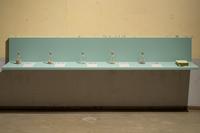Chapter 5IVE
Seed Stories (2018–)
Seed Stories, ongoing work since 2018
Seeds, bottles and prints
Since the beginning of time, seeds travelled with humans across the world. A well-known example are the seeds that enslaved people brought with them during their deportation, as a result of which many plants grow on the Northern and Southern American continent that have their origins in Africa and elsewhere in the world. Seeds gave (forced) migrants on their way to an unknown destination a sense of food security and the opportunity to build a new life. In addition, seeds also keep the memory of their place of origin alive, forming the legacy of the local conditions where they originate and often grow best. Due to the industrialisation, privatisation and commercialisation of the seed stock, seeds do not travel as they did in the past, and partly as a result, their variety has decreased significantly.
Futurefarmers is a collective consisting of farmers, biologists, philosophers, ecologists, and artists who, among other things, are engaged in collecting the migration stories of seeds. This usually involves seeds that were believed to be lost and were allegedly no longer produced. The seeds and their stories lead an inconspicuous existence, often among amateur historians or in close-knit cultural communities. Futurefarmers does not only collect the stories but also takes these seeds back on a journey to their place of origin, where they are shared with local farmers, who bring the returned seeds into production again.
In Chapter 5IVE, Futurefarmers show five different kinds of seeds and their corresponding migration stories. They also present a pamphlet written by the artist Massimo Ricciardo, who analyses the data collected in a Micro SD - a kind of memory chip used to store information by cell phone users - that belonged to an anonymous migrant landed on the shores of Sicily. The text emerges from a systematic analysis of the descriptive metadata of the files contained in the Micro SD (n. 70F): phone numbers, photographs, vocal memos, songs, recordings are can be considered seeds that accompanied this person on their flight. It is an encrypted story of a human being on the move due to a political or climatic situation.
